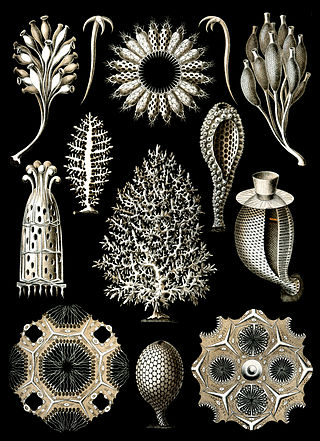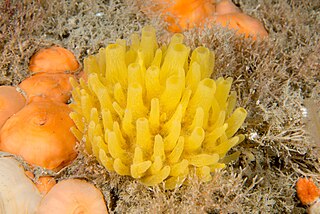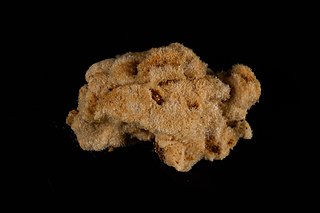
The calcareoussponges are members of the animal phylum Porifera, the cellular sponges. They are characterized by spicules made of calcium carbonate, in the form of high-magnesium calcite or aragonite. While the spicules in most species are triradiate, some species may possess two- or four-pointed spicules. Unlike other sponges, calcareans lack microscleres, tiny spicules which reinforce the flesh. In addition, their spicules develop from the outside-in, mineralizing within a hollow organic sheath.
Ascute is a genus of calcareous sponges. It contains two species, both found in Australia:

Polymastia is a genus of sea sponges containing about 30 species. These are small to large encrusting or dome-shaped sponges with a smooth surface having many teat-shaped projections (papillae). In areas of strong wave action, this genus does not grow the teat structures, but instead grows in a corrugated form.
Ascaltis pelliculata is a species of sea sponge in the family Leucascidae, first described as Leucoselenia pelliculata by Arthur Dendy in 1891. it is found in the coastal waters of Victoria.
Leuconia is a genus of calcareous sponges in the family Baeriidae. It was described by English anatomist and zoologist Robert Edmond Grant in 1833.
Leucopsila is a genus of poriferans in the family Baeriidae. It contains one species, Leucopsila stylifera, which was originally described as Leuconia stylifera in 1870. The genus was described by Dendy & Row in 1913.
Ascute uteoides is a species of calcareous sponge found in Australia.

Arturia is a genus of calcareous sponge in the family Clathrinidae which contains 14 species. It is named after Arthur Dendy, a prominent researcher of calcareous sponges. It was renamed Arturia in 2017 because the name Arthuria was already assigned to a genus of molluscs.
Clathrina camura is a species of calcareous sponge from the Atlantic Ocean.

Notodoris serenae is a species of sea slug. It is a dorid nudibranch, a shell-less marine gastropod mollusc in the family Aegiridae.
Baeriidae is a family of calcareous sponges in the class Calcarea. It was named by Borojevic, Boury-Esnault, and Vacelet in 2000. The type genus is BaeriaMiklucho-Maclay, 1870, by original designation, though Baeria is now considered a junior synonym of LeuconiaGrant, 1833.
Trichogypsiidae is a family of sponges in the class Calcarea.
Soleneiscus radovani is a species of calcareous sponge in the family Dendyidae, and was first described in 1999 by Gert Wörheide and John Hooper. The species epithet, radovani, honours Radovan Borojevic for "his substantial and pioneering achievements in calcarean taxonomy".
Leucetta villosa is a species of calcareous sponge in the family Leucettidae, and was first described in 1999 by Gert Wörheide and John Hooper. The species epithet, villosa, comes from the Latin, villosus ("hairy"), and was given because of the "hair-like extensions on the sponge surface".

Leucetta is a genus of sponges in the family Leucettidae, which was first described in 1872 by Ernst Haeckel. The type species is Leucetta primigenia Haeckel, 1872 by subsequent designation.
Vosmaeropsis macera is a species of calcareous sponge in the family Heteropiidae, and was first described in 1886 by Henry John Carter as Heteropia macera, and was later described as Vosmaeropsisis dendyi by Row and Hôzawa in 1931. It is the type species of the genus, Vosmaeropsis. The species epithet, macera, comes from the Latin, macer.
Leucettusa lancifera is a species of calcareous sponge in the family Leucaltidae first described by Arthur Dendy in 1924, and found in New Zealand waters,.

Leucettusa tubulosa is a species of calcareous sponge in the family Leucaltidae first described by Arthur Dendy in 1924, and found in New Zealand waters,.
Ascoleucetta is a genus of sponges in the family Leucascidae, first described in 1924 by Arthur Dendy and Leslie M. Frederick.

Leucetta primigenia is a species of calcareous sponge in the family Leucettidae, and was first described in 1872 by Ernst Haeckel.








